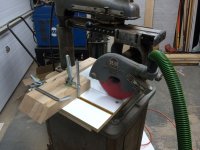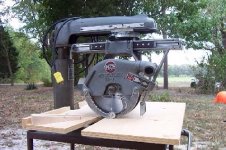I've had my eye on a Kapex for a while, but the funds for one have not magically appeared yet. So, I decided to see what else I could get until that day comes. I really did not want to get a less expensive and lesser quality miter saw, and I also had no need to be mobile. Enter the radial arm saw. People almost give these things away. I found a very old Delta Multiplex 20A for $30. I added a Freud 56 tooth blade and a new table with a Incra T-track. The Festool quick clamps work quite well with this. I now have the fence dialed in at a perfect 90 degrees. I will be using this saw to complete my build of a new kitchen table.
[attachimg=1]
One of the things I like about this saw is that it's really not that big. There's also something satisfying about taking an old quality tool and putting it back in use. So far the cuts with the Freud blade are incredibly clean. I also have dust collection hooked up, but I'll need to add a better dust-collecting guard to get it more effective. I have invested just under $100 (not including the Festool clamps), and I think this saw should serve me well.
[attachimg=1]
One of the things I like about this saw is that it's really not that big. There's also something satisfying about taking an old quality tool and putting it back in use. So far the cuts with the Freud blade are incredibly clean. I also have dust collection hooked up, but I'll need to add a better dust-collecting guard to get it more effective. I have invested just under $100 (not including the Festool clamps), and I think this saw should serve me well.


